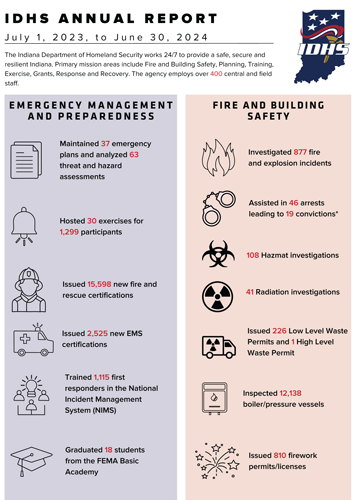The Indiana Department of Homeland Security (IDHS) leads Indiana's emergency planning and operations, first responder training and fire and building safety. The Division of Fire and Building Safety (within IDHS) oversees building code enforcement, fire investigations and hazmat and radiation programs. It also certifies and trains thousands of first responders each year. The Emergency Management and Preparedness Division works with local and national partners on emergency planning, preparedness and response, including the State Emergency Operations Center (SEOC), which leads response and coordination efforts for large-magnitude incidents. The agency also administers state- and federal-funded grant programs. Learn more about IDHS on the Agency Overview page.
Putting Public Safety Data to Use
Local fire departments and EMS providers regularly submit incident data to IDHS through the ImageTrend system. That information is compiled into reports by national entities, IDHS and others. These reports help spot trends that can drive changes in efforts from the national and state levels to the local level. The data from those reports is also made available to the local agencies and public through interactive dashboards, which show cases when agencies responded to an incident. These are mapped and incident counts are tabulated to help users gain a better understanding of first response activities on the local, county, district and state levels. Similarly, IDHS tracks fatalities that occur in residential settings in an interactive dashboard. Learn more about these dashboards and how they fit into the overall effort to reduce public safety risks on the Community Risk Reduction page.
Requests for data not presented on the IDHS website can be made on the IDHS APRA Portal.
IDHS Annual Reports
Selected Annual Data
- Fire and Building Safety
Code Enforcement Inspections
Fiscal Year Building Inspections 2023-24 18,256 2022-23 15,575 2021-22 13,847 2020-21 12,847 2019-20 13,141 2018-19 13,715 2017-18 12,839 Building Plan Review
Fiscal Year Construction Design Releases Issued Variances for Structures Approved 2023-24 11,329 1,174 2022-23 11,285 870 2021-22 11,037 905 2020-21 11,007 695 2019-20 11,597 1,205 2018-19 11,705 1,149 2017-18 11,562 1,019 Fire Investigations
Fiscal Year Suspicious Fires Investigated Arrests 2023-24 877 47 2022-23 815 44 2021-22 583 35 2020-21 678 43 2019-20 535 43 2018-19 528 21 2017-18 563 22 - Plans and Exercises
Emergency Response Plans
Fiscal Year Plans Maintained Plans Reviewed/Revised/Exercised 2023-24 37 30 2022-23 83 13 2021-22 71 22 2020-21 71 25 2019-20 71 12 2018-19 46 13 2017-18 24 9 - First Responder Certifications, Graduates
EMS Certifications
Fiscal Year Paramedics Licensed Emergency Medical Technicians Certified Advanced Emergency Medical Technicians Certified Emergency Medical Responders Certified Primary Instructors Certified Emergency Vehicle Operator Certifications 2023-24 393 1,330 109 594 101 538 2022-23 300 1,549 124 568 81 310 2021-22 76 1,252 57 601 67 410 2020-21 302 1,184 80 465 65 449 2019-20 247 1,164 68 476 52 462 2018-19 247 1,126 60 541 42 336 2017-18 281 1,088 77 510 52 426 Emergency Responders, Emergency Managers and Search & Rescue Training
Fiscal Year Firefighters, Rescuers, Officers, Investigators & Instructors Certified Incident Command System Graduates K-9 Teams, Search & Rescue Graduates 2023-24 16,354 1,139 321 2022-23 13,251 1,116 180 2021-22 12,768 938 206 2020-21 11,264 722 164 2019-20 9,726 272 159 2018-19 11,974 757 442 2017-18 10,739 910 467 - Hazmat and Radiation Programs
Radioactive Materials Transportation & Emergencies
Fiscal Year Total Number of Incidents Responded to Total Number of Shipment Permits Issued for Highway Route Control Quality Radioactive Materials Total Number of Shipment Permits Issued for High-Level Radioactive Waste or Spent Nuclear Fuel Total Number of Shipment Permits Issued for Low-Level Radioactive Waste Total Number of Responders Trained for Radiation Response/
DetectionTotal Number of Responders Trained for Radiological Emergency Preparedness/
Nuclear Power Plant2023-24 137 44 0 220 194 58 2022-23 99 27 0 181 122 30 2021-22 141 43 1 162 135 23 2020-21 400 41 0 167 - - 2019-20 160 32 1 173 258 688 2018-19 159 63 173 400 279 2017-18 183 35 235 395 266 Chemical Emergency Protection
Reporting Year Total Tier II Payments Collected Annual Tier II Reports Submitted 2023 $652,020 6,612 2022 $744,060 6,516 2021 $789,440 6,438 2020 $654,370 6,399 2019 $674,050 6,470 2018 $763,860 5,932 2017 $630,671 5,758 - Grants
Emergency Management Performance Grant (EMPG)
The EMPG program makes grants available to states to assist state, local, territorial and tribal governments in preparing for all types of hazards.
Fiscal Year Total Dollar Amount of Grants Awarded Grant Sub-Recipients Projects Counties in Which Grants Were Awarded 2023-24 (FFY24) $3,303,030.11 91 91 91 2022-23 (FFY23) $3,321,392.00 91 91 91 2021-22 (FFY22) $3,913,137.00 129 129 90 2020-21 (FFY21) $4,534,114.00 140 140 91 2019-20 (FFY20) $2,701,067.00 91 91 91 2018-19 (FFY19) $3,248,092.00 116 116 92 2017-18 (FFY18) $3,790,000.00 109 113 90 2016-17 (FFY17) $3,000,000.00 158 158 91 2015-16 (FFY16) $3,386,001.50 195 195 90 Find more information at the Emergency Management Performance Grant page.
Hazardous Materials Emergency Preparedness (HMEP)
HMEP grants are awarded to Local Emergency Planning Committees (LEPCs) and are used for the following purposes:
- Implementing risk driven, capabilities-based state homeland security strategies
- Supports state and local abilities to prevent, protect against, mitigate, respond to and recover from acts of terrorism and other catastrophic events.
- Developing, improving and implementing emergency plans
- Training public sector hazardous materials emergency response employees to respond to incidents involving hazardous materials in transportation
- Determining flow patterns of hazardous materials within a state and between states
- Determining the need within a state for regional hazardous materials emergency response teams
Fiscal Year Total Dollar Amount of Grants Awarded Grant Sub-Recipients Projects Counties in Which Grants Were Awarded 2024-25 (FFY25) $375,263.00 27 27 26 2023-24 (FFY24) $386,863.00 29 29 29 2022-23 (FFY23) $419,110.00 35 35 28 2021-22 (FFY22) $393,429.00 40 40 36 2020-21 (FFY21) $370,505.00 37 37 34 2019-20 (FFY20) $376,624.00 47 47 43 2018-19 (FFY19) $279,497.00 36 36 30 2017-18 (FFY18) $207,000.00 17 17 17 2016-17 (FFY17) $506,202.00 34 49 34 2015-16 (FFY16) $372,833.00 43 65 43 Find more information at the Hazardous Materials Emergency Preparedness Grant Program page.
Nonprofit Security Grant Program (NSGP)
The Nonprofit Security Grant Program (NSGP) is a competitive grant program for physical security enhancements and other security-related activities to nonprofit organizations that are at risk of a terrorist attack.
Fiscal Year Total Dollar Amount of Grants Awarded Grant Sub-Recipients Projects Counties in Which Grants Were Awarded 2023-24 (FFY24) $9,002,700.00 52 65 22 2022-23 (FFY23) $5,920,158.00 42 45 18 2021-22 (FFY22) $6,461,517.00 42 41 19 2020-21 (FFY21) $4,857,565.00 40 47 16 2019-20 (FFY20) $2,436,508.00 33 33 14 2018-19 (FFY19) $292,769.00 4 4 4 2017-18 (FFY18) $353,810.00 5 5 4 2016-17 (FFY17) $121,490.00 2 2 1 Find more information at the Nonprofit Security Grant Program page.
Secured School Safety Grant Program
Fiscal Year Total Dollar Amount Awarded Number of Award Recipient Schools or School Systems 2025-26 (FY26) $27,031,881.25 494 2024-25 (FY25) $24,206,587.95 499 2023-24 (FY24) $29,824,803.67 474 2022-23 (FY23) $22,911,714.45 425 2021-22 (FY22) $19,058,808.05 392 2020-21 (FY21) $19,432,122.54 418 2019-20 (FY20) $19,081,470.02 429 2018-19 (FY19) $14,256,526.80 388 2017-18 (FY18) $7,952,283.06 217 2016-17 (FY17) $6,332,608.84 171 2015-16 (FY16) $7,958,281.97 225 2014-15 (FY15) $8,532,681.26 241 2013-14 (FY14) $8,357,377.21 226 Find more information at the Secured School Safety Grant Program page.
The awarding of grants began in 2014 and continues annually through the Indiana Grants Management System (iGMS). Since 2014, more than $214 million has been awarded to Indiana schools that meet the eligibility requirements in their grant requests.
From FY14 to FY26, the Indiana Secured School Grant Board has approved 4,599 grant requests.
Note: Before FY2020, there were only three categories, which were School Resource Officers, Equipment and Threat Assessments. Since FY2020, three categories have been added: Active Event Early Warning System, Student and Parent Support Services, and Other Training.
- FY2026 Award Information
- FY2025 Award Information
- FY2024 Award Information
- FY2023 Award Information
- FY2022 Award Information
- FY2021 Award Information
- FY2020 Award Information
- FY2019 Award Information
- FY2018 Award Information
- FY2017 Award Information
- FY2016 Award Information
- FY2015 Award Information
- FY2014 Award Information
State Homeland Security Program (SHSP)
The SHSP program supports the implementation of risk-driven, capabilities-based state homeland security strategies to address capability targets set in urban area, state and regional Threat and Hazard Identification and Risk Assessments (THIRA).
Fiscal Year Total Dollar Amount of Grants Awarded Grant Sub-Recipients Projects Counties in Which Grants Were Awarded 2023-24 (FFY24) $4,144,612 34 34 33 2022-23 (FFY23) $3,878,000.00 35 35 35 2021-22 (FFY22) $4,605,125.00 37 37 26 2020-21 (FFY21) $4,372,375.00 35 35 29 2019-20 (FFY20) $4,073,125.00 38 38 34 2018-19 (FFY19) $3,260,000.00 41 41 28 2017-18 (FFY18) $3,184,000.00 70 70 61 2016-17 (FFY17) $2,737,334.00 54 54 50 2015-16 (FFY16) $1,008,165.00 50 50 42 Find more information at the State Homeland Security Program page.
Indiana Local Body Camera Grant Program
Fiscal Year Total Dollar Amount Awarded Number of Award Recipients 2022-23 (FY23) $479,152 30 2021-22 (FY22) $1,172,126.38 71 The state of Indiana, through procedures established by the Indiana State Police and administered by the Indiana Department of Homeland Security, provides matching grants to city, town and county law enforcement agencies for the acquisition of body-worn cameras.
Find more information at the Local Body Camera Grant page.
Indiana Homeland Security Foundation Grant Program
The grant program funded public safety projects at the local level through the sale of Secure Indiana license plates.
Fiscal Year Total Dollar Amount of Grants Awarded Grant Recipients Counties in Which Grants Were Awarded 2022-23 (FY23) The Foundation was dissolved in 2023 (House Enrolled Act 1001). - - 2021-22 (FY22) $116,746.00 31 31 2020-21 (FY21) $133,212.00 37 37 2019-20 (FY20) $180,999.94 51 42 2018-19 (FY19) FY19 was skipped to allow the Foundation
and Secured School Safety grants to be on the same fiscal cycle.- - 2017-18 (FY18) $250,854.00 66 46 2016-17 (FY17) $91,561.44 31 27 2015-16 (FY16) $168,364.00 98 31

